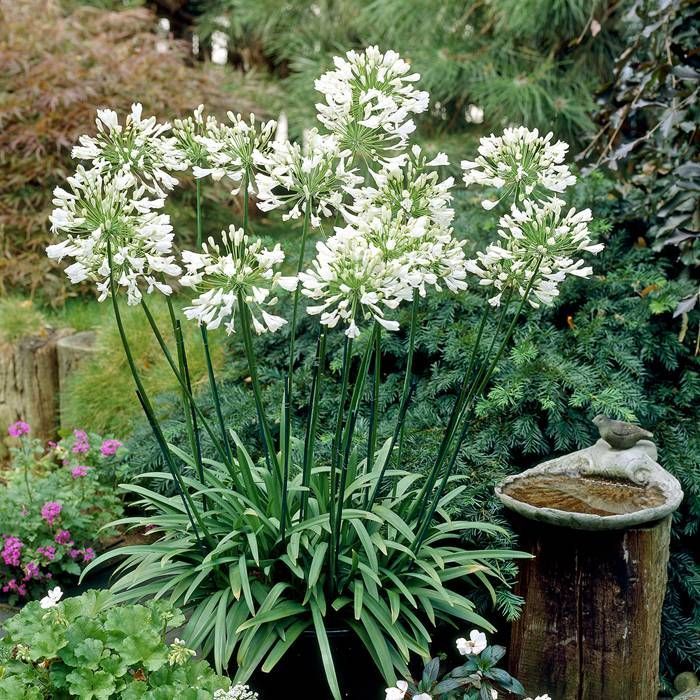Agapanthus Propagation: Tips for Expanding Your Plant Collection
Agapanthus Propagation: Tips for Expanding Your Plant Collection
Blog Article
Mastering the Art of Agapanthus Treatment: Essential Actions for Healthy And Balanced Growth and Vivid Blooms
In the world of horticulture, the farming of agapanthus stands as a rewarding undertaking for those who seek to support these sophisticated flowering plants. With their striking blossoms and stylish foliage, agapanthus has actually recorded the attention of gardeners worldwide. Nevertheless, accomplishing optimal development and dynamic blooms requires a nuanced method that incorporates different essential steps. From selecting the appropriate selection to grasping trimming techniques, the trip in the direction of cultivating growing agapanthus plants is diverse and holds the vital to unlocking the full capacity of these organic treasures.

Choosing the Right Agapanthus Variety

When choosing the ideal Agapanthus selection for your yard, take into consideration elements such as climate viability, bloom shade, and development habit. Furthermore, consider the environment in your area to ensure the Agapanthus selection you select can thrive in your certain conditions. Understanding the development routine of various Agapanthus varieties is critical for appropriate positioning within your yard.
Ideal Growing Conditions
Thinking about the optimum ecological requirements is crucial for successful Agapanthus farming. Agapanthus plants are sensitive to cool temperatures and need to be safeguarded from frost throughout wintertime months.
To ensure healthy and balanced growth and lively flowers, plant Agapanthus light bulbs at a deepness of concerning 2-4 inches and area them 8-12 inches apart. Adding natural matter, such as compost, to the dirt can improve drainage and fertility, promoting durable root advancement. Mulching around the base of the plants helps preserve moisture and subdues weed growth. Normal watering is crucial, particularly during the expanding season, to maintain the dirt regularly wet but not soaked.
Watering and Fertilizing Tips
Maintaining proper wetness degrees and offering necessary nutrients are crucial components in the care program for Agapanthus plants. It is important to strike a balance when it comes to sprinkling Agapanthus. If overwatered, these plants like consistently damp soil however are vulnerable to root rot. Throughout the expanding season, water deeply when a week, guaranteeing the dirt is well-draining to protect against waterlogging. In hotter climates or during periods of dry spell, more frequent watering may be necessary to maintain the soil uniformly damp. However, decrease watering in the wintertime to stop waterlogged conditions.
Feeding Agapanthus is crucial for advertising healthy and balanced growth and prolific blossoms. Use a balanced plant food, such as a 10-10-10 formula, in the early spring as brand-new development emerges. By adhering to these watering and fertilizing tips, you can ensure your Agapanthus plants flourish and create dynamic, lasting blooms.
Pruning Methods for Agapanthus
Trimming Agapanthus plants at the appropriate times and with appropriate techniques is important for maintaining their health and wellness and promoting ideal development and blooming. The optimal time to trim Agapanthus is in late winter months or early spring before brand-new development arises.
For flowered stems, wait until the flowers have perished and after that cut them back to the base. This not only cleans up the plant's look however likewise motivates the advancement of new flower buds. Deadheading invested blossoms can likewise reroute the plant's energy into creating more blooms as opposed to setting seeds. Nevertheless, if you desire to gather seeds for propagation, find more information leave some blossoms to completely dry and fully grown on the plant.
Keep in mind to use tidy, sharp tools to make exact cuts and decrease the danger of introducing diseases. Agapanthus. Routine trimming will assist maintain your Agapanthus looking neat and healthy and balanced while guaranteeing an abundant display of beautiful blossoms
Handling Usual Parasites and Illness
After ensuring correct pruning methods for Agapanthus, it is vital to resolve common insects and conditions that can impact the wellness and vigor of these plants. Agapanthus plants are generally hardy but can still succumb to specific concerns. One common parasite that impacts Agapanthus is the Agapanthus gall midge. This tiny, orange fly lays its eggs in the foliage, leading to distorted development and flower buds that stop working to open up. To fight this parasite, prune and damage any kind of afflicted plant parts and take into consideration making use of insecticidal soap.
Another common concern is fungal leaf area, which presents as dark sores on the fallen leaves. To stop fungal illness, make certain good air circulation around the plants, avoid overhanging watering, and eliminate any contaminated fallen leaves immediately. Furthermore, Agapanthus plants can struggle with origin rot if they are grown in inadequately draining pipes dirt. To avoid this, plant Agapanthus in well-draining soil and stay clear of overwatering. By being watchful and taking timely activity versus illness and insects, you can aid your Agapanthus plants grow and produce lively blooms.

Verdict
In verdict, grasping the art of agapanthus care includes choosing the ideal variety, offering perfect planting problems, proper watering and fertilizing, suitable pruning techniques, and dealing with usual insects and conditions. By adhering to these crucial steps, you can guarantee healthy and balanced development and vibrant blossoms for your agapanthus plants. Keep in mind to routinely keep track of and preserve your plants to advertise their overall health and longevity.
To make certain healthy and balanced growth and vivid flowers, plant Agapanthus light bulbs at read this post here a deepness of regarding 2-4 inches and room them 8-12 inches apart. By adhering to these watering and feeding ideas, you can ensure your Agapanthus plants prosper and produce lively, lasting flowers.
One common pest that affects Agapanthus is the Agapanthus gall midge. Furthermore, Agapanthus plants can suffer from origin rot if they are grown in poorly draining pipes dirt. By adhering to these essential steps, Our site you can make sure healthy and balanced development and vivid blossoms for your agapanthus plants.
Report this page